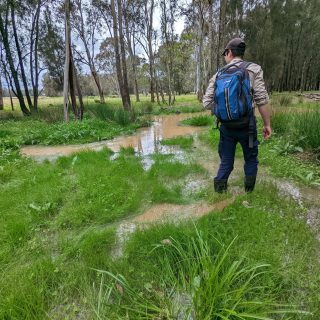Aboriginal Hearth Complexes at Yea
Over the past year, the Biosis heritage team has been undertaking salvage excavations of Aboriginal archaeological places on the Goulburn river floodplain at Yea, in central Victoria. The work is being carried out with our clients, Barro Group, and with the Taungurung Clans Aboriginal Corporation (Registered Aboriginal Party and traditional owners of this country), in advance of sand and gravel extraction.
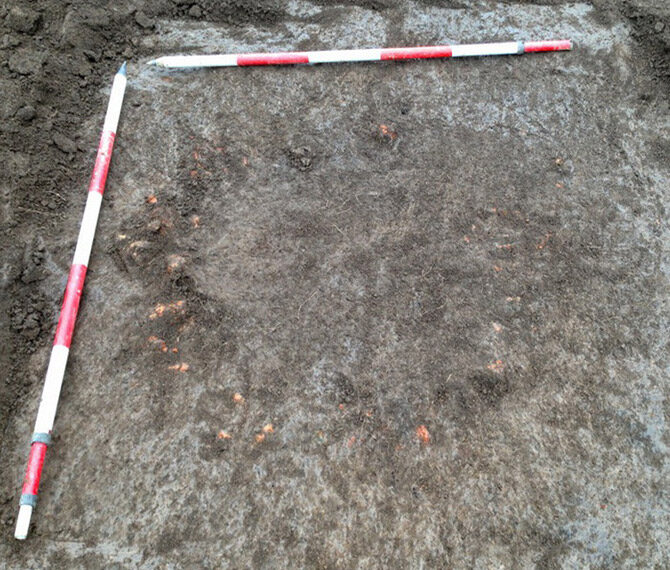
Investigations have revealed a complex of Aboriginal settlement sites occupying the former alluvial ridges of the floodplain. These sites probably date to the later Holocene (within the past 5,000 years), when this pastoral landscape was open grassy woodland dominated by River Red-gum, separated by lower-lying wetlands.
Using a combination of continual machine transects and area excavations, recording in metre sections and horizontal spits, the team has been able to extract virtual 3D cross-sections through the extensive archaeological sites. The results, now being analysed, offer a remarkably detailed picture of life in these former woodlands on the river floodplain. Unusually, the investigations have identified complexes of Aboriginal hearths or ovens, better known in other parts of Australia but rarely found on pastoral farmlands in Victoria. Typically, the hearths at Yea are found clustered along the edges of the alluvial silt ridges, close to the sources of wetland clay and stream pebbles which provided the heat stones used in these hearths.
The native oven is made by digging a circular hole in the ground, of a size corresponding to the quantity of food to be cooked. It is then lined with stones in the bottom and a strong fire made over them so as to heat them thoroughly, and dry the hole. As soon as the stones are judged to be sufficiently hot, the fire is removed, and a few of the stones taken, and put inside the animal to be roasted if it be a large one. A few leaves or a handful of grass, are then sprinkled over the stones in the bottom of the oven, on which the animal is deposited, generally whole, with hot stone, which had been kept for that purpose, laid on top of it. It is covered with grass, or leaves, and then thickly coated over with earth, which effectually prevents the heat from escaping.
Edward John Eyre, 1845, Journals of Expeditions of Discovery into Central Australia. Chapter III. T. and W. Boone, London.
Plate 1:
[caption id="attachment_3313" align="aligncenter" width="640"]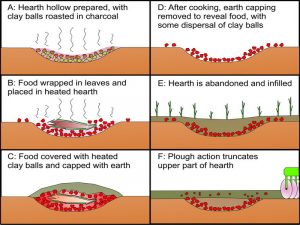 Reconstruction of clay ball ovens found at Yea[/caption]
Reconstruction of clay ball ovens found at Yea[/caption]
Plate:2
A clay ball hearth (oven) found at Yea, as first discovered. Note the exposed ring of reddish burnt clay lumps (clay balls) which define the rim of the infilled hearth.
[caption id="attachment_3315" align="aligncenter" width="640"]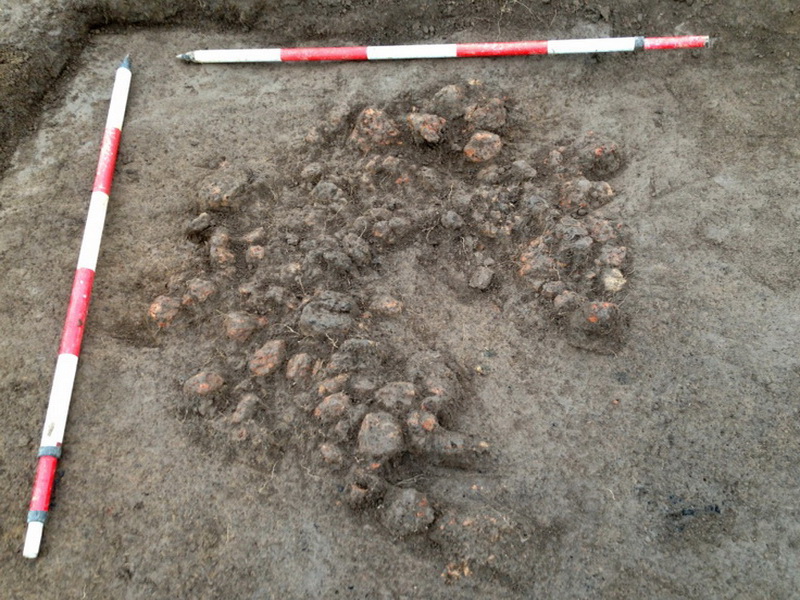 The same hearth after excavation. Notice the scooped-out channel to the lower right, which may have been caused during the preparation or cooking process, or by the removal of the food.[/caption]
The same hearth after excavation. Notice the scooped-out channel to the lower right, which may have been caused during the preparation or cooking process, or by the removal of the food.[/caption]
Different hearth types
Two main types of hearth have been identified at Yea. Type 1 hearths use combinations of stone and fired clay balls as heat retainers. Type 2 hearths rely entirely on fired clay balls. Type 1 hearths tend to be found at shallow depths and may be most recent (perhaps dating to a time when there was good exposure of stone along the stream beds). Some of the all-clay Type 2 hearths (like that shown in Plates 2 and 3 above) have been found at deeper levels, and these examples have been least affected by plough damage. Type 1 hearths, however, are poorly preserved. Did these hearths have different designs or functions?
Plate 4:
[caption id="attachment_3316" align="aligncenter" width="640"]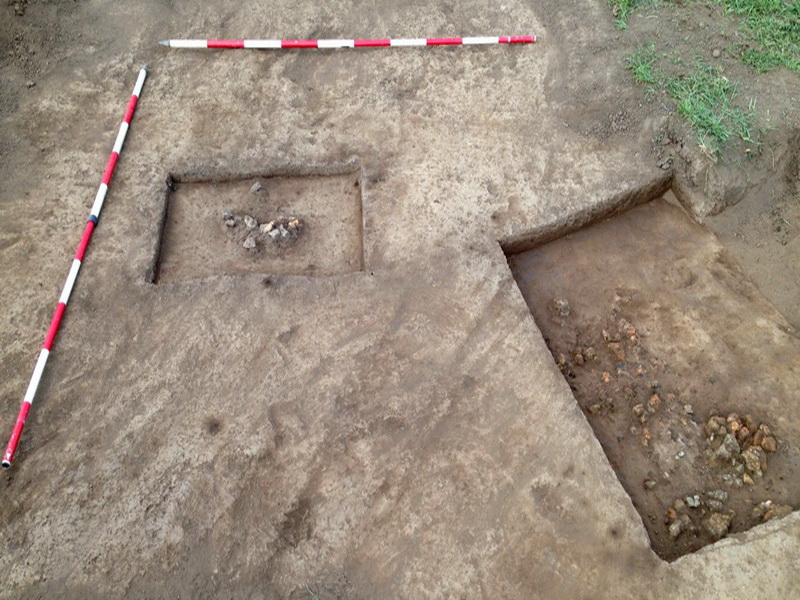 Type 1 hearth of stone and clay (left) with Type 2 hearth entirely of clay, found at a slightly lower level (right). (See Plates 5 and 6).[/caption]
Type 1 hearth of stone and clay (left) with Type 2 hearth entirely of clay, found at a slightly lower level (right). (See Plates 5 and 6).[/caption]
Plate 5:
[caption id="attachment_3317" align="aligncenter" width="640"]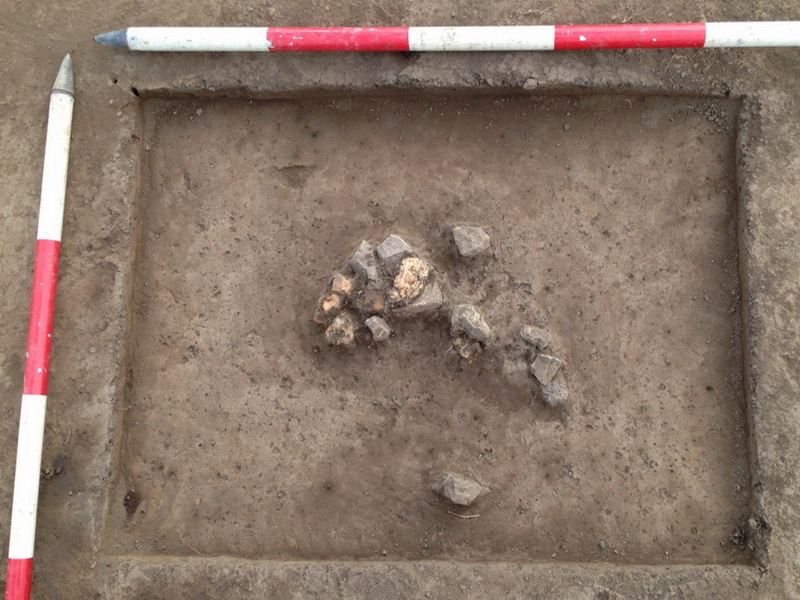 Detail of Hearth 189 (seen in Plate 4 above). This plough-damaged hearth uses heat retainers of fired clay, burnt Humevale siltstone and quartz.[/caption]
Detail of Hearth 189 (seen in Plate 4 above). This plough-damaged hearth uses heat retainers of fired clay, burnt Humevale siltstone and quartz.[/caption]
Plate 6:
[caption id="attachment_3318" align="aligncenter" width="640"]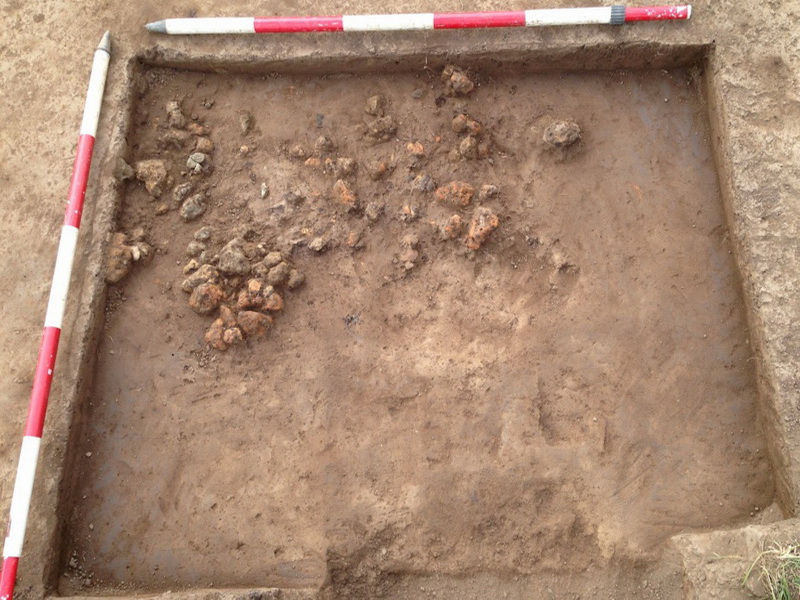 Hearth 190 (seen on the right in Plate 4). Unlike Hearth 189, this example uses heat retainers made entirely of fired clay.[/caption]
Hearth 190 (seen on the right in Plate 4). Unlike Hearth 189, this example uses heat retainers made entirely of fired clay.[/caption]
The hearths found at Yea will be subjected to further detailed study, including radiocarbon dating. It is hoped that archaeomagnetic analyses may be undertaken by Dr Andy Herries and his team at The Australian Archaeomagnetic Laboratory, La Trobe University. The fired hearth material may provide sources for paleointensity analysis, measuring the heat intensity reached in the hearths. Fired clay and stone in situ may also retain a remnant magnetic vector aligned with the contemporary magnetic field, allowing the dated hearths here to help calibrate a local palaeosecular curve for future archaeomagnetic studies in Australia.






